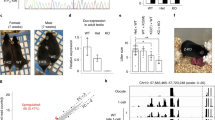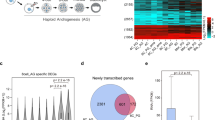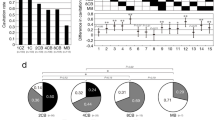Abstract
There has been much speculation on whether mammalian eggs with two male pronuclei can develop normally. Eggs with two female pronuclei can sometimes develop as far as the 25-somite stage1–3 but with only very meagre extraembryonic tissues2,3. We suggested that the genome undergoes specific imprinting during gametogenesis3 and that some paternal genes may be necessary for normal development of the extraembryonic tissues3,4, in which only the maternal X chromosome remains active5–9. However, the need for the maternal genome for development to term is not yet unequivocally established. The detailed study described here demonstrates that while between 40 and 50% of heterozygous reconstituted eggs with a male and a female pronucleus develop to term, none of the eggs with two male pronuclei does so. Furthermore, embryos in the latter case are very retarded, even though the trophoblast develops relatively well compared with embryos having two female pronuclei1–3. Our combined results indicate that while the paternal genome is essential for the normal development of extraembryonic tissues, the maternal genome may be essential for some stages of embryogenesis.
This is a preview of subscription content, access via your institution
Access options
Subscribe to this journal
Receive 51 print issues and online access
$199.00 per year
only $3.90 per issue
Buy this article
- Purchase on Springer Link
- Instant access to full article PDF
Prices may be subject to local taxes which are calculated during checkout
Similar content being viewed by others
References
Kaufman, M. H., Barton, S. C. & Surani, M. A. H. Nature 265, 53–55 (1977).
Surani, M. A. H. & Barton, S. C. Science 222, 1034–1036 (1983).
Surani, M. A. H., Barton, S. C. & Norris, M. L. Nature 308, 548–550 (1984).
Wakasugi, N. J. Reprod. Fert. 41, 85–96 (1974).
West, J. D., Frels, W. I., Chapman, V. M. & Papaioannou, V. E. Cell 12, 873–882 (1977).
Takagi, N., Wake, N. & Sasaki, M. Cytogenet. Cell Genet. 20, 240–248 (1978).
Harper, M. I., Fosten, M. & Monk, M. J. Embryol. exp. Morph. 67, 127–135 (1982).
Morris, T. Genet. Res. 12, 125–135 (1968).
Hoppe, P. C. & Illmensee, K. Proc. natn. Acad. Sci. U.S.A. 74, 5657–5661 (1977).
Hoppe, P. C. & Illmensee, K. Proc. natn. Acad. Sci. U.S.A. 79, 1912–1916 (1982).
Modlinski, J. A. J. Embryol. exp. Morph. 60, 153–161 (1980).
Markert, C. L. J. Hered. 73, 390–397 (1982).
Gulyas, B. J., Wood, M. & Whittingham, D. G. Devl Biol. 101, 246–250 (1984).
Gardner, R. L. & Papaioannou, V. E. in The Early Development of Mammals (eds Balls, M. & Wild, A. E.) 107–132 (Cambridge University Press, 1975).
Bagshawe, K. D. & Lawler, S. D. Br. J. Obstet. Gynaec. 89, 255–257 (1982).
Johnson, D. R. Genetics 76, 795–805 (1974).
McLaren, A. in Maternal Effects in Development (eds Newth, D. R. & Balls, M.) 287–320 (Cambridge University Press, 1979).
McGrath, J. & Solter, D. Nature 308, 550–551 (1984).
McGrath, J. & Solter, D. Cell 37, 179–183 (1984).
Whittingham, D. G. & Wales, R. G. Aust. J. biol. Sci. 22, 1065–1072 (1969).
Whittingham, D. G. J. Reprod. Fert. Suppl. 14, 7–21 (1971).
McGrath, J. & Solter, D. Science 220, 1300–1302 (1983).
Neff, J. M. & Enders, J. F. Proc. Soc. exp. Biol. Med. 127, 260–271 (1968).
Giles, R. E. & Ruddle, F. H. In Vitro 9, 103–118 (1973).
Graham, C. F. Acta endocr. Suppl. 153, 154–167 (1971).
Chapman, V. M., Whitten, W. K. & Ruddle, F. H. Devl Biol. 26, 153–161 (1971).
Author information
Authors and Affiliations
Rights and permissions
About this article
Cite this article
Barton, S., Surani, M. & Norris, M. Role of paternal and maternal genomes in mouse development. Nature 311, 374–376 (1984). https://doi.org/10.1038/311374a0
Received:
Accepted:
Issue Date:
DOI: https://doi.org/10.1038/311374a0
This article is cited by
-
Reprogramming mechanism dissection and trophoblast replacement application in monkey somatic cell nuclear transfer
Nature Communications (2024)
-
The contribution of imprinted genes to neurodevelopmental and neuropsychiatric disorders
Translational Psychiatry (2022)
-
Naïve pluripotent-like characteristics of non-tumorigenic Muse cells isolated from human amniotic membrane
Scientific Reports (2022)
-
DNA Methylation Analysis of Imprinted Genes in the Cortex and Hippocampus of Cross-Fostered Mice Selectively Bred for Increased Voluntary Wheel-Running
Behavior Genetics (2022)
-
Genomic imprinted genes in reciprocal hybrid endosperm of Brassica napus
BMC Plant Biology (2021)
Comments
By submitting a comment you agree to abide by our Terms and Community Guidelines. If you find something abusive or that does not comply with our terms or guidelines please flag it as inappropriate.



